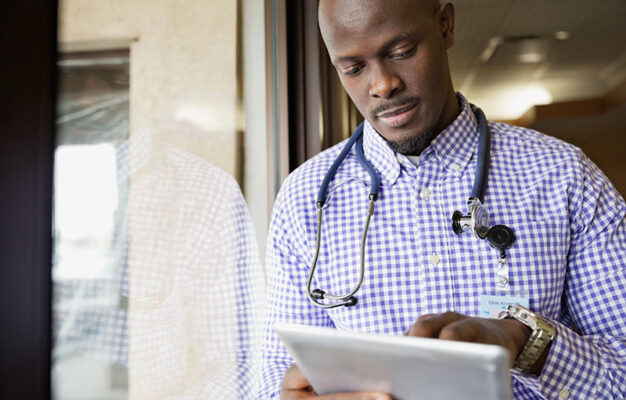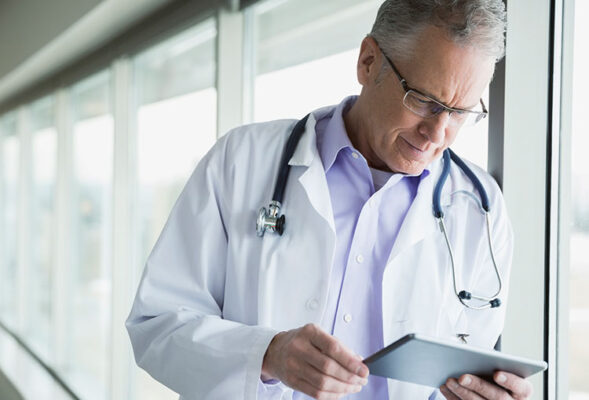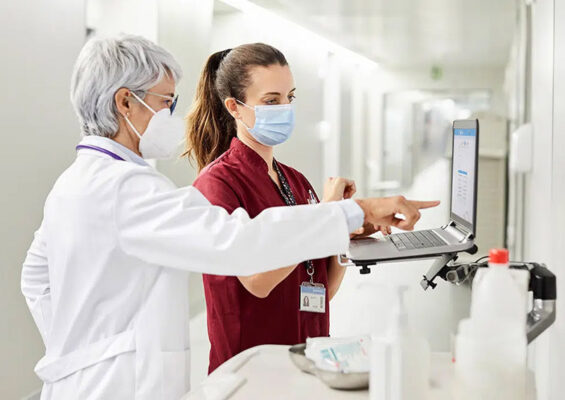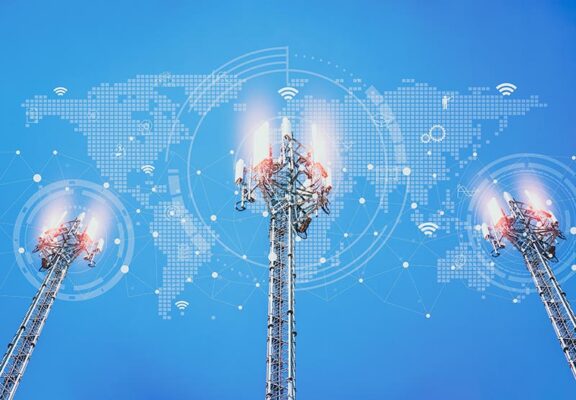Estimated reading time: 8 minutes

Biotech companies depend on real-world data (RWD) and real-world evidence (RWE) for:
- Decentralized clinical trials
- Efficacy monitoring
- Post-market safety and surveillance
- Digital patient engagement
However, gathering and protecting these valuable insights can be challenging. This is especially true for rural residents, older people and those with mild cognitive or physical impairments.
A connectivity gap exists since most solutions are developed for smartphones with Android™ or Apple enabled by Bluetooth® wireless technology. While Bluetooth technology has benefits, it’s not accessible to everyone.
Carsten Brockmann, Telit Cinterion’s director of market strategy and connected health care, says newcomers to connected devices or those without reliable, affordable, high-speed internet can find it overwhelming.
The push to expand trial access to a more diverse patient population and increase digital patient engagement is gaining momentum. The industry needs various technologies that meet people where they are.
“That’s where 4G- and 5G-enabled technology comes in. It’s already here, and it’s prebundled and prefabricated. You can easily use it in a decentralized clinical environment.”
Carsten Brockmann, Director of Market Strategy, Telit Cinterion

Biotech and clinical research organizations use these technologies to support cellular remote patient monitoring (RPM) sensors and gateways that don’t require smartphones with Bluetooth technology. Solutions based on cellular network technology require less effort on the participants’ parts. Still, they deliver always-on RWD and RWE that are fully authenticated and cybersecure.
Table of Contents
Benefits Cellular-Based Solutions Deliver for RPM
1. Faster Time to Market
Connecting vital sign sensors to patients’ consumer phones and smartwatches via Bluetooth technology is easy at the edge. However, it can be tricky with the plethora of vendor-specific cloud systems. Integration efforts can take up to 18 months of development before the FDA or Medical Device Reporting (MDR) approval cycle even begins.
“Cellular networks don’t have this challenge. They’re end-to-end secured and ready for approval and deployment right away. This is a clear win for go-to-market acceleration.”
Carsten Brockmann, Director of Market Strategy, Telit Cinterion
2. Better Recruitment and Retention with Cellular RPM

Even the most patient-focused trials require a lot from their participants. The higher the real and perceived burdens, the less likely people are to enroll in or stay in a trial. Patient-friendly, cellular-based health technology is easier for people of all ages and abilities to access and use. It enables:
- Access to secure high-speed internet
- Easy-to-use Internet of Things (IoT) technology
- Interoperability, as many participants and patients use multiple devices or solutions
IoT technology allows decentralized clinical trials (DCTs) to be rolled out easily to remote trial cohorts. This is of growing importance as companies and regulatory agencies embrace DCTs. They allow for more efficient remote participant recruiting and fewer necessary clinical visits. They also guarantee patient data authenticity and privacy throughout the trial journey.
Icon, a clinical research organization, conducted one of the first fully decentralized studies with a patient questionnaire as one of the primary outcomes. The questionnaire was filled out using a smartphone app. Trial participants found these tools more convenient than using a tablet at a trial site.
Having easy-to-use tools is useful for patient retention. Companies can monitor patient adherence and receive real-time alerts of unexpected events.
“Remote monitoring was conducted using a Fitbit device. Both the app and Fitbit leveraged a cellular network, allowing a real-time, round-the-clock view of the patients.
Now, patients have the full study in their pocket. That’s made possible because we have the cellular network.
Moreover, patients can easily interact with the team and the physician. That’s what’s going to keep them in the system.”
Alexandre Malouvier, Senior Director of Scientific Affairs and Digital Innovation, Icon
3. Post-Market Upsides
Beyond DCTs and market studies, cellular network technology produces post-market upsides, too, such as:
- Gathering data for pharmacovigilance
- Streamlining patient communication
- Monitoring and identifying opportunities to monetize digital patient engagements, hybrid therapeutics and precision medicine
“In the United States, reimbursement policies for digital health solutions are evolving rapidly. Pharma companies can directly benefit from this evolution for their digital patient engagement strategies by adopting mature RPM using cellular mobile networks.
RPM opens various reimbursement pathways. The United Kingdom, France and Germany are relatively mature markets. These governments are promoting the digitization of care and have standardized reimbursement pathways.”
Carsten Brockmann, Director of Market Strategy, Telit Cinterion
Malouvier has seen cellular devices and digital endpoints show that medical intervention positively affects real-life patient outcomes and behavior. For example, Fitbit devices can demonstrate that people with hemophilia became more active following treatment. He added that cellular-connected devices can also provide higher-quality data on patient monitoring, behavior and adherence than was previously possible.
4. Highest-Level Security

The cellular network provides a dedicated, certified, automatic connection directly to back-end systems. Organizations can ensure data privacy protections are in place.
Data security is especially crucial for people who rely on public Wi-Fi for high-quality connections. While affordable, this option is not secure, putting personally identifiable information (PII) and protected health information at risk. 4G- or 5G-enabled solutions encrypt data when you connect to the network.
“They are also free from the shifting government policies and security concerns related to offshore servers. Cybersecurity is baked into the chips.”
Carsten Brockmann, Director of Market Strategy, Telit Cinterion
Supporting Health Equity, Personalized Care and Patient-Focused Drug Development
“With medical IoT connectivity, patient centricity becomes the new normal for pharma, paving the way for digital therapies and personalized medicine.”
Carsten Brockmann, Director of Market Strategy, Telit Cinterion
Cellular network technology empowers biotech firms to reduce health inequities and support personalized medicine and person-centered digital therapeutics and devices.
Digital disease management has been associated with a 45% reduction in the three-month rate of major adverse cardiovascular events, as well as a 50% reduction in 30-day readmission rates for patients following acute myocardial infarction.
Health Equity

The CDC defines health equity as a state in which “everyone has a fair and just opportunity to attain their highest level of health.” Moreover, no one is disadvantaged in achieving this potential because of injustices, health disparities or other obstacles to health and health care.
RPM based on 4G and 5G technology is an effective lever to mitigate harmful social determinants of health, including:
- Limited internet infrastructure
- Unaffordable transportation to appointments
- Prohibitive access to clinics and research hospitals
It also removes a technology barrier that makes enrolling people traditionally underrepresented in trials difficult.
There were 56.8 million connected home medical monitoring devices on the market by the end of 2021, and this number is expected to hit 126.1 million in 2027.
Person-Centered Care

Personalized medicine is possible with individual and population health data gathered during decentralized trials and ongoing remote patient monitoring. This field is growing quickly. There were 56.8 million connected home medical monitoring devices on the market by the end of 2021. This number is expected to hit 126.1 million in 2027.
Precision digital therapeutics and interventions can also mitigate detrimental SDOH and have been shown to improve outcomes. For example, digital disease management has been associated with a 45% reduction in the three-month rate of major adverse cardiovascular events. It’s also linked to a 50% reduction in 30-day readmission rates for patients following acute myocardial infarction.
RPM enabled for cellular networks creates a pathway for real- and near-time tracking data and patient insights so companies can:
- Monitor drug adherence
- Respond to patterns in individual and population data
- Deliver patient education content
- Initiate interventions quickly
- Perform post-market surveillance
- Patient-focused drug and device development
Person-centered care requires patient-centered drugs and devices. That’s why the FDA advocates for patient-focused drug development to “ensure that patients’ experiences, perspectives, needs, and priorities are captured and meaningfully incorporated.”
The agency encourages approaches and best practices to promote patient enrollment and minimize the burden on trial participants. One way to meet this recommendation is to leverage cellular networks’ ease of use and accessibility. Leveraging these features can boost care access without traveling to a trial site or medical office.
Brockmann stated that medical device manufacturers connect millions of outpatients annually in remote monitoring for conditions, including:
- Sleep apnea
- Cardiac rhythm monitoring
- Diabetes treatment
“Smart pharma companies and their CROs can use proven 4G and 5G technologies for RPM to get more real-world evidence from large patient cohorts. That would open a wide revenue gap for other entrepreneurs, care innovators or big tech to fill.”
Carsten Brockmann, Director of Market Strategy, Telit Cinterion
Investing in Cellular RPM Technology
Cellular RPM and digital health solutions offer an affordable, accessible method to collect RWD and RWE to support market initiatives and clinical decision-making. Investing in 4G- and 5G-enabled RPM positions biotech companies to develop treatments and interventions that improve the quality of life for patients. In addition, it enhances business sustainability for organizations.
“Smart pharma companies and CROs don’t want to miss the direct digital path to their patient cohorts. That would open a wide revenue gap for other entrepreneurs, care innovators or big tech to fill.”
Carsten Brockmann, Director of Market Strategy, Telit Cinterion

With medical IoT connectivity based on trusted Western technology, life sciences companies can:
- Leverage better patient insights
- Broaden access to treatments
- Gain an edge in the growing digital therapeutics and precision medicines markets
Companies that embrace mobile 4G and 5G medical IoT technology will see gains across their businesses. Furthermore, they will design better, more personalized treatments backed by the best data insights possible.
Health care professionals and device manufacturers are harnessing IoT to improve patient experiences through remote health condition monitoring. Speak to a connected health care expert at Telit Cinterion to learn what we can do for your IoT remote health condition monitoring solutions.
Key Takeaways
- Cellular-based health care solutions can accelerate time to market. Connecting vital sign sensors through cellular networks allows faster development and approval cycles.
- Cellular-based health technology is patient-friendly and more accessible to people of all ages and abilities. Cellular RPM addresses health equity issues by mitigating social health detriments like limited internet infrastructure and prohibitive clinic access.
- Cellular networks provide a dedicated, secure connection that ensures patient data remains private and protected.


